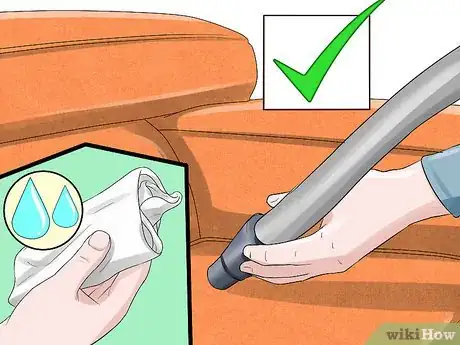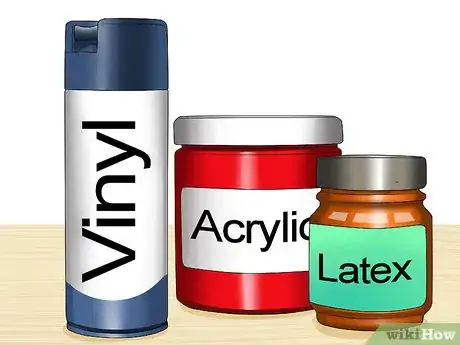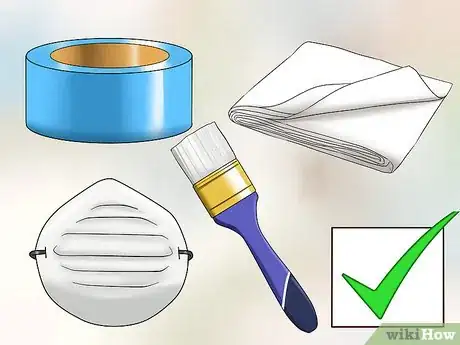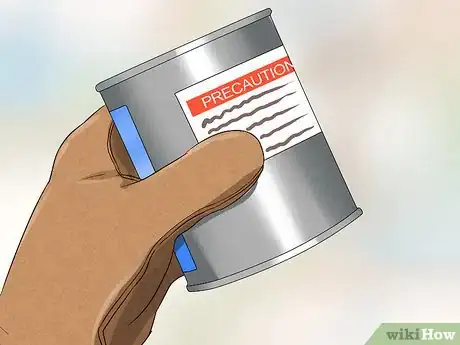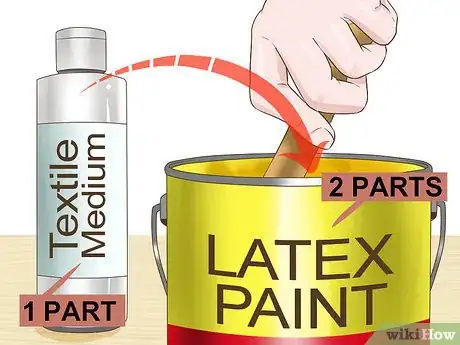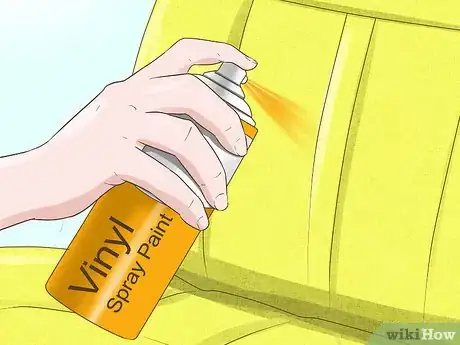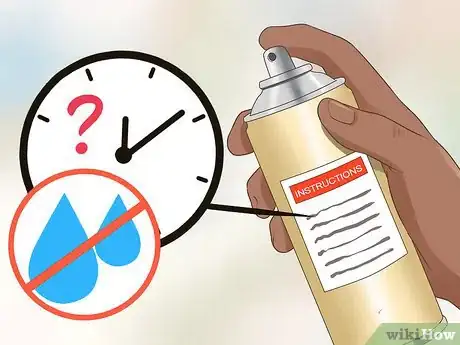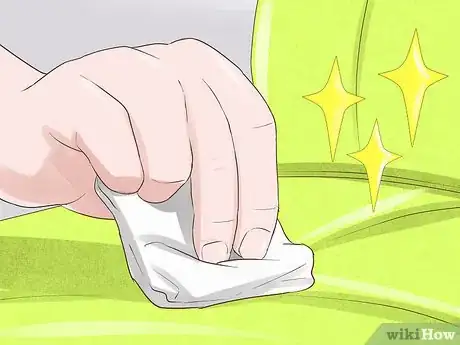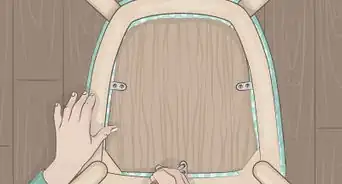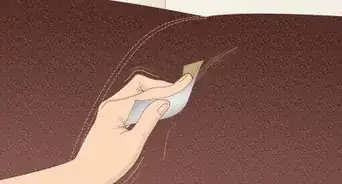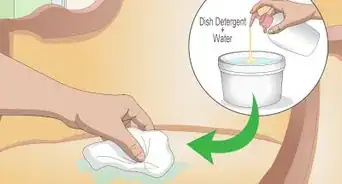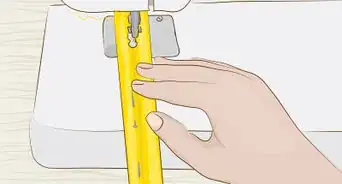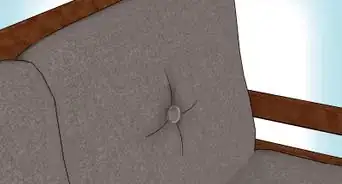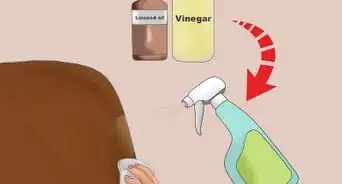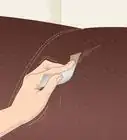This article was co-authored by wikiHow Staff. Our trained team of editors and researchers validate articles for accuracy and comprehensiveness. wikiHow's Content Management Team carefully monitors the work from our editorial staff to ensure that each article is backed by trusted research and meets our high quality standards.
This article has been viewed 24,355 times.
Learn more...
Painting upholstery can be a great way to spruce it up or change a look. Whether it is the upholstery on a chair in your home, or the seat of your car, upholstery paint can be applied to give a surface a much needed facelift. However, when applying paint to upholstery you need to make sure that you have the right supplies and that you are using the right techniques. If you do, you can give new life to an old, worn out surface.
Steps
Organizing Your Project
-
1Clean the surface. Whether your upholstery is fabric or vinyl, you will need to clean the surface before you start applying paint to it. Vinyl can be wiped down with a damp cloth. Be sure to remove any debris or dirt that is stuck onto the surface. Fabric should be vacuumed and cleaned with soap before paint application.[1]
- Cleaning the surface well before painting assures that the paint will stick better to the upholstery surface.
- Be sure that both types of surface are completely dry before paint application.
-
2Pick a paint. There are a wide variety of paint products that can be used to paint upholstery. What product you use depends on what type of surface you are painting and what type of application process you would like to use. Products can include:[2]
- Spray paint for vinyl: Paints made for vinyl come in a spray can. They may be made for furniture or car upholstery purposes.
- Spray paint for cloth: There are a wide variety of sprays made for cloth surfaces. Read the labels of those you are considering to make sure they will stand up the the use you are envisioning.
- Brush-on paint for cloth: There are several types of brush-on paints that can be used for upholstery. There are some specifically made for upholstery and there are other paints, such as regular latex paint, that can be used for this purpose as well.
Advertisement -
3Set up your work area. As with painting most things, you need to protect other surfaces around from drips or over spray. This means putting down a drop cloth and taping off any surfaces that might accidentally get paint on them.[3]
- You may need brushes, painter's tape, drop clothes, and a dust mask when painting. Get these supplies ahead of time so that you don't have to run to the store at the last minute.[4]
- It is better to be safe than sorry when it comes to painting prep. Mask off more areas than you think might accidentally get paint on them so that you don't have an unfortunate mistake with the paint.
-
4Take safety precautions. When doing a craft project you should always take your safety, and the safety of those around you, into consideration. This means that you need to think about the need for ventilation, eye protection, protective clothing, and any other safety supplies that may be needed before doing your project.
- If you are unsure whether you need to take safety precautions, look at the labels on all of the products you will be using and see if they have any safety precautions on them. This is a good place to start.
Applying Paint to Upholstery
-
1Prepare the paint, if necessary. If you are using regular latex paint to paint your upholstery, you will need to amend it. This means adding textile medium to the paint so that it sticks to the fabric.[5]
- Mix together one part paint and two parts textile medium in a jar. This will thin out the latex paint and allow it to bond with the fabric.
-
2Apply an undercoat, if necessary. If you are applying paint to vinyl upholstery, you may need to apply an undercoat that helps the paint stick to the vinyl. This is only necessary for certain paints, so look at the directions of the paint you bought to make sure.[6]
- The undercoat may be applied with a brush or from a spray can. This varies depending on the specific product you are using.
-
3Apply the first coat. Spray or paint on the first coat. Depending on the specific directions supplied on the product you are using, your first coat will either be very thin or thick enough to cover up the previous color of the upholstery.[7]
- If you are painting vinyl, you want to be focused on a smooth, streak-less coat that does not drip. This is usually done by applying thin coats.
- If you are painting fabric, your first coat is likely to soak in a lot. You may not have complete coverage but just make sure that the entire surface has paint applied to it.
-
4Allow the paint to dry between coats. It is important to let your paint coats dry completely between coats. This assures that the paint solidifies and sticks to the surface you are painting correctly. It also assures that subsequent coats dry quicker.[8]
- Follow the directions on the paint container for dry times between coats. Each paint may take a different amount of time to dry.
-
5Apply additional coats. Put on more layers of paint until the surface is covered to your satisfaction. This may be only one more coat, or it could be numerous additional coats.[9]
- Be patient and do as many coats as it takes to get the finish you want. Skipping additional coats can lead to a less polished finish or a shorter lifespan for the paint.
Maintaining Your Project
-
1Follow directions about drying time. Remember to follow the drying time directions on the paint packaging. Allowing each coat to dry completely before applying the next coat will potentially help to make your finished product look better and last longer.
- The drying time between paint coats will vary widely depending on the paint that you are using, the thickness that it is applied, and the climate it is being applied in.
- Keep your project in a safe place until it dries completely. This will allow it to dry completely before being disturbed.
- Avoid using your painted surface for anything until 100% dry.
-
2Maintain the surface properly. In order to keep your painted upholstery looking good, you will need to be careful with it and clean it gently. For example, if you spill something on it, soak as much up as possible quickly with a dry towel and then blot the surface with a damp cloth.
- Painted upholstery can be more sensitive to use and abuse than fabric surfaces. Be sure to avoid setting rough or sharp surfaces on the upholstery, as it could scratch your paint job.
-
3Fix the surface with touchup paint or additional coats. If you paint upholstery you can always repaint sections or add new coats in the future. This can give your surface a whole new life after you have used it quite a bit.
- Like with your original painting project, you should take the time to thoroughly clean the surface before you add additional coats in the future. This will help assure that the new coats stick to the old painted surface.
Things You'll Need
- Upholstery
- Cleaning cloth
- Paint
- Paint brushes
- Masking tape
- Drop cloth
- Safety supplies
References
- ↑ https://www.youtube.com/watch?v=4y-EzYH3mcc
- ↑ https://www.apartmenttherapy.com/diy-project-test-lab-results-we-tried-3-fabric-paints-on-upholstery-and-heres-what-happened-218302
- ↑ http://www.familyhandyman.com/painting/tips/10-tips-for-a-perfect-paint-job/view-all
- ↑ http://www.familyhandyman.com/painting/tips/10-tips-for-a-perfect-paint-job/view-all
- ↑ https://www.apartmenttherapy.com/diy-project-test-lab-results-we-tried-3-fabric-paints-on-upholstery-and-heres-what-happened-218302
- ↑ https://www.youtube.com/watch?v=4y-EzYH3mcc
- ↑ https://www.youtube.com/watch?v=4y-EzYH3mcc
- ↑ http://www.familyhandyman.com/painting/tips/10-tips-for-a-perfect-paint-job/view-all
- ↑ http://www.familyhandyman.com/painting/tips/10-tips-for-a-perfect-paint-job/view-all
